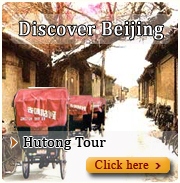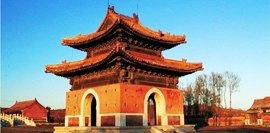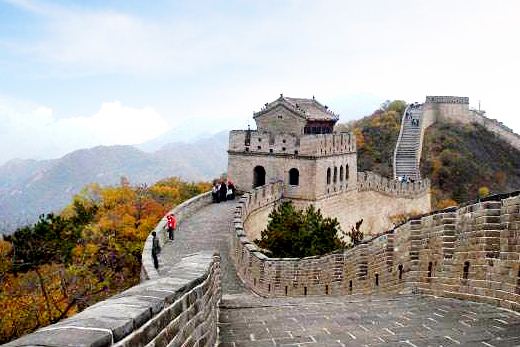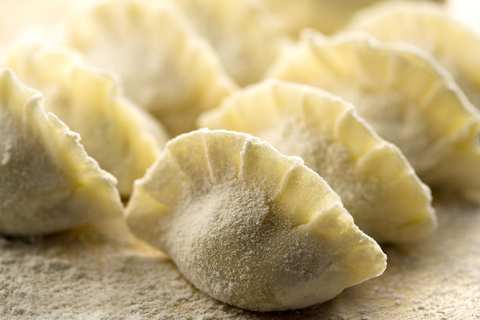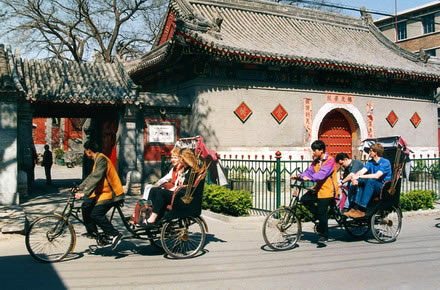 One of the unique features of Beijing is its numerous Hutongs which means small lanes. The life of ordinary people in these lanes contributes greatly to the charm of this ancient capital. In these small lanes, you'll find many siheyuan, or quadrangles which are the living quarters of ordinary Beijingers. At present, there are about 4,550 hutongs, the broadest over four meters wide and the smallest -- the eastern part of Dongfu' an Hutong, a mere 70 cm across -- just wide enough for a single person to traverse. Although the city has changed a great deal over the last 500 years, the hutongs remain much the same as during Ming and Qing times.
One of the unique features of Beijing is its numerous Hutongs which means small lanes. The life of ordinary people in these lanes contributes greatly to the charm of this ancient capital. In these small lanes, you'll find many siheyuan, or quadrangles which are the living quarters of ordinary Beijingers. At present, there are about 4,550 hutongs, the broadest over four meters wide and the smallest -- the eastern part of Dongfu' an Hutong, a mere 70 cm across -- just wide enough for a single person to traverse. Although the city has changed a great deal over the last 500 years, the hutongs remain much the same as during Ming and Qing times.
Beijing's best known hutongs are of three types: centers of government offices, residential areas for nobles and officials, and old markets. Lumicang (Salary Rice Granary) Hutongs, in the neighborhood of today' s Nanxiao Street, is the site of the former nine imperial granaries of the late Ming and early Qing. Each year, large amounts of grain were brought in from Zhejing Province to the capital and stored in Lumicang District. Hutongs in the area took on the names of the various granaries, names that have stuck to this day. Then there's Xishiku (Western General Warehouse) Alley off Xi' anmennei Street, once called Houku Dajie (Back Warehouse Street) for its 10 warehouses serving the imperial palaces and gardens.
Dongchang (Eastern Prosperity) Hutong, originally called Dongchang (eastern Yard) Hutong, located south of the National Art Galley, was named in the Yongle period for the offices of the newly created eunuch administration. The Dongchang had a reputation for terrorizing innocent people. It was here that the eunuchs Liu Jin and Wei Zhongxian had numerous people, including members of the imperial family, high officials and nobles, put to death.
The second group of hutongs is named after the officials or nobles who resided there. When Emperor Yongle of the Ming Dynasty established Beijing as the capital, most of his officials moved from Nanjing. The alleys they lived in took on their names. Yongkang Hutong in the north was originally named Marquis Yongkang Lane after the Yongkang Marquis, Xu Zhong. Sanbulao Hutong on the West City District was originally named Sanbao Laodie (Father Sanbao) Alley after the "Sanbao" court eunuch, Zheng He, who lived there. Sanbao is a corruption of the original name; Laodie is a term of respect for an elder person.
In the East City District is the Red Star Hutong, once named His Excellency Wuliang (Immeasurable) Alley, taken from the name of Emperor Hongwu's general Wu Liang (Written differently from wuliang , immeasurable). In Xisi (Western Four Archways), there are the Front, middle and Rear Maojiawan hutongs, said to have once been home of the Ming Dynasty scholar Mao Wenjian.
Finally. There are those hutongs, which derive their names from old markets and trading centers. These include Xianyukou (Fresh Fish Market), Luomasi (Horse and Mule Market), Gangwasi (Pottery Market), Yangsi (Goat Market), Meisi (Coal Market) and Zhubaosi (Jewelry Market). Other hutongs are named for historical sites and ancient relics. Qilinbei (Unicorn Stela) Hutong, north of Eastern Di' anmen Street, is named for a Ming Dynasty stela that once stood at its entrance.


 About Beijing
About Beijing 